
Filippo Grandi, the Commissioner for Refugees, claimed more than 70% of the world’s refugees and displaced people reside in Afghanistan, according to reports.
Since the Taliban seized power in August last year, the Afghan people have endured the worst human rights abuses and continue to live in abject poverty. Other climate-vulnerable nations, such as the Democratic Republic of the Congo, Syria, and Yemen, in addition to Afghanistan, also have a sizable number of displaced people, according to Grandi.
“Afghanistan is not on the agenda of COP27, and there is no official representative of Afghanistan in this conference. I attended as an unofficial representative,” news reports quoted Abdul Hadi Achakzai, an unofficial representative of Afghanistan in the COP27, as saying.
The displaced families expressed concern that it has become more challenging to thrive on a daily basis as a result of climate change and impending winters.
As winter draws near, some Afghan families who have been uprooted by climate change expressed their extreme fear.
According to reports, Sharif is one of the people who had to leave the Parwan province and travel to Kabul as a result of the flooding that occurred there in August of this year.
“The flood hit our home and destroyed it. I have nothing here now,” said Basri Gul, another displaced person.
As the winter season is drawing closer, Afghanis’ concern for the humanitarian crisis has grown.
According to the most recent assessment from the Office for the Coordination of Humanitarian Affairs (OCHA), the country’s poverty rate increased from 47% to 97% in 3 years.
According to OCHA research, the poverty rate was 47% in 2020, increased to 70% in 2021, and reached 97% in 2022. According to the figures, 97% of Afghans live below the poverty line, and the country is experiencing one of the greatest humanitarian crises in the world.
According to Khaama Press, the rate of poverty in Afghanistan has been correlated with a number of circumstances, including a reduction in income, an increase in food prices and inflation, a drought, high unemployment, and natural disasters.















